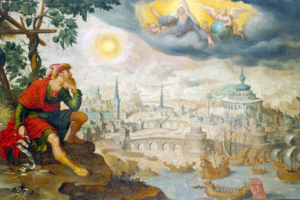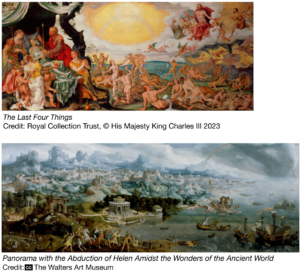Object of the Month: June 2023
Jonah Under the Gourd Vine
Oil on panel, monogrammed: D.F.
Maerten van Heemskerck (attr. to)
Dutch, 1498–1574
Maerten van Heemskerck was born the son of a farmer June 1498 in the Netherlands. He left the farm to study art under Cornelis Willemsz. in Haarlem and Jan Lucasz. in Delft. Between 1527-1530, Heemskerck placed himself under the tutelage of Jan van Scorel in Haarlem. M&G’s collection includes works by Scorel and Heemskerck’s biographer, Karl van Mander. Scorel had extensively studied in Utrecht (with Jan Gossaert), Germany (with Albrecht Durer), Switzerland, Venice, Jerusalem, Cyprus, Crete, and finally Rome. During his time in Rome, his artistic style was heavily influenced by the works of Michelangelo and Raphael. Scorel brought these new artistic ideas back with him to the Netherlands and taught them to Heemskerck.
Perhaps Scorel’s adventures inspired Heemskerck. Like many today in modern society, Heemskerck planned his own summer vacation. In 1532, he set off for an adventure with the primary purpose of seeing the Seven Wonders of the World. He left a parting gift for colleagues in the form of an altarpiece for St. Luke’s altar in Bavokerk depicting St. Luke painting Mary. He landed in Rome, July 1532. On his travels, he “made accurate, conscientious sketches of antique ruins and statues” (National Gallery of Art). He also was able to view for himself the works of Michelangelo and Raphael. In 1537, he returned to Haarlem where he remained for the rest of his life. He became well known for portraits, religious paintings, and producing designs for engravers.
M&G’s Jonah Under the Gourd Vine displays elements from Heemskerck’s travels. In the background behind Jonah, he includes the Vatican Obelisk as well as a bridge over the Tiber River which he probably saw during his time in Rome. In fact, the city of Nineveh looks more like the city of Rome than a city in the Middle East. Even the figure of Jonah mimics Michelangelo’s figures in The Creation of Adam. The whole composition imitates Heemskerck’s The Last Four Things as well as his Panorama with the Abduction of Helen Amidst the Wonders of the Ancient World.
Heemskerck depicts the portion of the story of Jonah where he has finally obeyed God’s call to preach repentance to the city of Nineveh. In Jonah 1:1, God commissioned Jonah to go to Nineveh and give the city a chance to turn from evil to God. However, Jonah thought that Nineveh deserved condemnation and judgment not mercy (Jonah 4: 2), so he attempted to run in the opposite direction toward Tarshish. Jonah’s disobedience resulted in his spending three days and three nights in the belly of fish before he repented, and God mercifully rescued him. Jonah now had a second chance to obey.
Jonah consented; he went and preached repentance to Nineveh. To his surprise, the whole city repented, including the king. Instead of rejoicing over those who repented, Jonah pouted in anger. Here Heemskerck portrays Jonah taking shelter under the leaves of a gourd vine overlooking the city of Nineveh with God looking down from the heavens. Trailing from his hand is a banner inscribed with BENE IRASCOR EGO VSQVE AD MORTEM IONA CA 4 16 which communicates Jonah’s true feelings: “Rightly I myself am exceedingly angry unto death, Jonah 4:16.” Having experienced God’s mercy first-hand and himself been given a second chance, Jonah should have delighted in God’s compassion. Sadly, he placed himself in the position of telling God what he believed God should have done—to pass judgment on the Ninevites. James 1:19-20 reminds us that unlike Jonah, we should follow God’s example and be “slow to wrath.”
Rebekah Cobb
M&G Collections Support Staff
Published 2023

